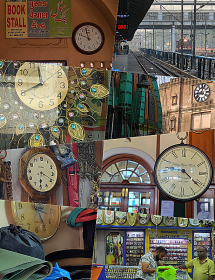Five and a half hours ahead of Greenwich Mean Time (GMT): India
INDIA IS A very large country. At its greatest width, it spans almost 1800 miles from east (the Manipur/Bangladesh border) to the west (the western edge of Kutch where it borders Pakistan.). When it is 4 am (GMT) in London, 1500 miles away in Moscow (Russia) and 1800 miles away in Ankara (Turkey), it is 7 am. Yet, when the sun rises at 4 am in the far east of India, people in Kutch (western Gujarat) will not see the sun rise until 5.30 am. In both places, the clock will show ‘4 am’. This difference arises because all of India (as well as Bangladesh and Sri Lanka) are in the same time zone (Indian Standard Time: ‘IST’). IST is five and a half hours ahead of Greenwich Mean Time (‘GMT’). Incidentally, while researching this piece, I noticed that clocks in Nepal are 5 ¾ hours ahead of GMT.

Some countries spanning many degrees of longitude such as India does, are divided into several time zones (e.g. the USA, the Democratic Republic of the Congo, and Russia). However, all of India is in a single time zone, I wondered why and whose idea it was in the first place.
Prior to the colonisation of India by the British, various methods of standardising time were adopted in different eras and under varying ruling regimes. For example, in the 4th century BC, the prime meridian was chosen as a line passing through what is now the modern town of Ujjain (in Madhya Pradesh) and the unit of time was based on the ‘prana’ (about 4 seconds – the length of a normal breath).
In 1802, John Goldingham, the official astronomer of the British East India Company, established Madras Time, which was 5 hours, 21 minutes and 14 seconds ahead of GMT. In 1884, Calcutta Standard Time was established. This was 5 hours, 53 minutes and 20 seconds ahead of GMT. It remained in use until 1948 despite other changes in time zoning having already occurred in India. At the same time as Calcutta Standard Time was created, Bombay Standard Time also came into existence – it was 4 hours and 51 minutes ahead of GMT. Although it no longer exists, it is still used in Parsi fire temples in Bombay.
Madras Time was used by the railways in British India until the 1st of January 1906, when IST came into existence. It was then that the geographical reference point for time standardisation was moved from Madras to Shankargarh Fort in the district of Allahabad. The reference meridian chosen, 82 degrees and 30 seconds East, was deemed to be the midpoint of India, as it was under British rule. In 1947, when India became independent, IST was kept as the country’s official time. However, both Calcutta Time and Bombay Time remained in use until 1948 and 1955 respectively. The idea of splitting India into two time zones has been mooted, but has yet to happen.
Although IST is the official time in all parts of India, an interesting variation is still in use in the tea gardens in the far east of the country (www.timeanddate.com/time/zone/india). Called ‘Chai Bagan Time (Tea Garden Time), it is one hour ahead of IST (and 6 ½ hours ahead of GMT). It was introduced by British tea companies to increase the number of daylight hours available for working, and is still in use. Using this timing, the sun rises at 5 in the morning instead of at 4 (IST) and sets at about 6 in the evening instead of 5 (IST).
Bombay Time has all but disappeared from use. However, it has been replaced by what some call ‘Bombay timing’, which refers to the habit of people to arrive incredibly late for appointments – especially social engagements. Finally, in a book about Bangalore by Peter Colaco, there is mention of yet another measure of time. There is ‘fie-mint’, which does not mean ‘five minutes’, but does mean ‘not very soon’. For example, he wrote:
“A waiter in a restaurant, once told me our order would take ‘fie-mint’. Did he mean a ‘five minute ‘fie-mint’ or a 30-minute ‘fie-mint’, I asked. He considered the question seriously. ‘Twenty-mint fie-mint’, he clarified.”



